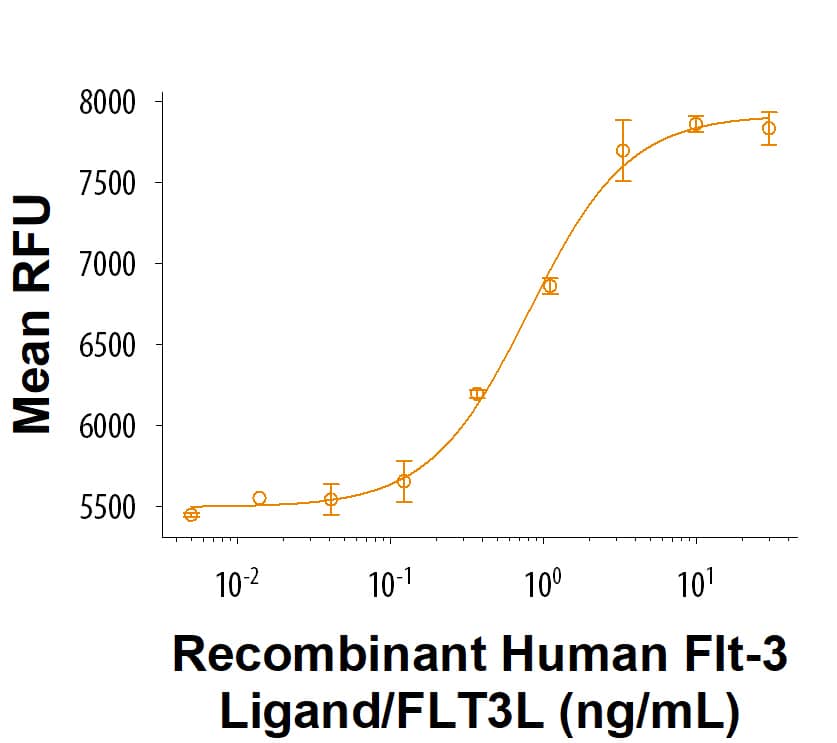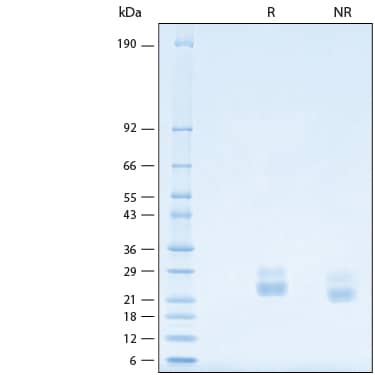Recombinant Human Flt-3 Ligand/FLT3L (HEK293) Protein, CF
Recombinant Human Flt-3 Ligand/FLT3L (HEK293) Protein, CF Summary
Product Specifications
Thr27-Pro185
Analysis
Product Datasheets
Carrier Free
CF stands for Carrier Free (CF). We typically add Bovine Serum Albumin (BSA) as a carrier protein to our recombinant proteins. Adding a carrier protein enhances protein stability, increases shelf-life, and allows the recombinant protein to be stored at a more dilute concentration. The carrier free version does not contain BSA.
In general, we advise purchasing the recombinant protein with BSA for use in cell or tissue culture, or as an ELISA standard. In contrast, the carrier free protein is recommended for applications, in which the presence of BSA could interfere.
308-FKHB
| Formulation | Lyophilized from a 0.2 μm filtered solution in PBS with Trehalose. |
| Reconstitution | Reconstitute the 10 μg size at 100 μg/mL in PBS. Reconstitute all other sizes at 250 μg/mL in PBS. |
| Shipping | The product is shipped at ambient temperature. Upon receipt, store it immediately at the temperature recommended below. |
| Stability & Storage: | Use a manual defrost freezer and avoid repeated freeze-thaw cycles.
|
Scientific Data
 View Larger
View Larger
Recombinant Human FLT-3LG Protein (Catalog # 308-FKHB) has a molecular weight (MW) of 44.9 kDa as analyzed by SEC-MALS, suggesting that this protein is a homodimer. MW may differ from predicted MW due to post-translational modifications (PTMs) present (i.e. Glycosylation).
 View Larger
View Larger
Recombinant Human Flt-3 Ligand/FLT3L (HEK293) Protein (Catalog # 308-FKHB) stimulates cell proliferation in the BaF3 mouse pro-B cell line transfected with mouse Flt-3. The ED50 for this effect is 0.150-1.50 ng/mL.
 View Larger
View Larger
2 μg/lane of Recombinant Human Flt-3 Ligand/FLT3L (HEK293) Protein (Catalog # 308-FKHB) was resolved with SDS-PAGE under reducing (R) and non-reducing (NR) conditions and visualized by Coomassie® Blue staining, showing bands at 22-31 kDa.
Reconstitution Calculator
Background: Flt-3 Ligand/FLT3L
Flt‑3 Ligand, also known as FLT3L, is an alpha-helical cytokine that promotes the differentiation of multiple hematopoietic cell lineages (1-3). Mature human Flt‑3 Ligand consists of a 158 amino acid (aa) extracellular domain (ECD) with a cytokine-like domain and a juxtamembrane tether region, a 21 aa transmembrane segment, and a 30 aa cytoplasmic tail (4-7). Within the ECD, human Flt‑3 Ligand shares 71% and 65% aa sequence identity with mouse and rat Flt‑3 Ligand, respectively (4-6). The human and mouse Flt‑3 Ligand proteins show cross-species activity. Flt-3 Ligand is also structurally related to M-CSF and SCF. Flt-3 Ligand is widely expressed in various human and mouse tissues. It is expressed as a noncovalently-linked dimer by T cells and bone marrow and thymic fibroblasts (1, 8). Each 36 kDa chain of the Flt-3 Ligand dimer carries approximately 12 kDa of N- and O-linked carbohydrates (8). Alternate splicing and proteolytic cleavage of the transmembrane form of the Flt-3 Ligand protein can generate a soluble 30 kDa fragment that includes the cytokine-like domain (4, 8). Alternate splicing of human Flt‑3 Ligand also generates membrane-associated isoforms that contain either a truncated cytoplasmic tail or an 85 aa substitution following the cytokine-like domain in the ECD of the Flt-3 Ligand protein (4, 5, 8). Both transmembrane and soluble forms of Flt‑3 Ligand signal through the tyrosine kinase receptor Flt-3/Flk-2 (3, 4, 6, 7). Flt‑3 Ligand induces the expansion of monocytes and immature dendritic cells as well as early B cell lineage differentiation (2, 9). Additionally, Flt-3 Ligand synergizes with IL-3, GM-CSF, and SCF to promote the mobilization and myeloid differentiation of hematopoietic stem cells (4-6). Flt-3 Ligand also cooperates with IL-2, IL-6, IL-7, and IL-15 to induce NK cell development and with IL-3, IL-7, and IL-11 to induce terminal B cell maturation (1, 10). Animal studies show that Flt‑3 Ligand reduces the severity of experimentally induced allergic inflammation (11).
- Wodnar-Filipowicz, A. (2003) News Physiol. Sci. 18:247.
- Dong, J. et al. (2002) Cancer Biol. Ther. 1:486.
- Gilliland, D.G. and J.D. Griffin (2002) Blood 100:1532.
- Hannum, C. et al. (1994) Nature 368:643.
- Lyman, S.D. et al. (1994) Blood 83:2795.
- Lyman, S.D. et al. (1993) Cell 75:1157.
- Savvides, S.N. et al. (2000) Nat. Struct. Biol. 7:486.
- McClanahan, T. et al. (1996) Blood 88:3371.
- Diener, K.R. et al. (2008) Exp. Hematol. 36:51.
- Farag, S.S. and M.A. Caligiuri (2006) Blood Rev. 20:123.
- Edwan, J.H. et al. (2004) J. Immunol. 172:5016.
FAQs
No product specific FAQs exist for this product, however you may
View all Proteins and Enzyme FAQsReviews for Recombinant Human Flt-3 Ligand/FLT3L (HEK293) Protein, CF
There are currently no reviews for this product. Be the first to review Recombinant Human Flt-3 Ligand/FLT3L (HEK293) Protein, CF and earn rewards!
Have you used Recombinant Human Flt-3 Ligand/FLT3L (HEK293) Protein, CF?
Submit a review and receive an Amazon gift card.
$25/€18/£15/$25CAN/¥75 Yuan/¥2500 Yen for a review with an image
$10/€7/£6/$10 CAD/¥70 Yuan/¥1110 Yen for a review without an image



